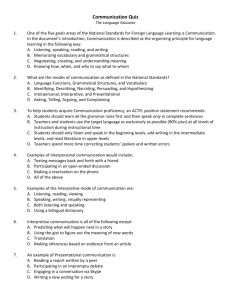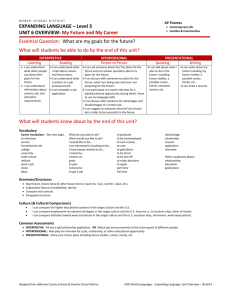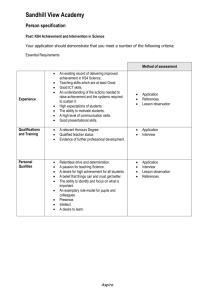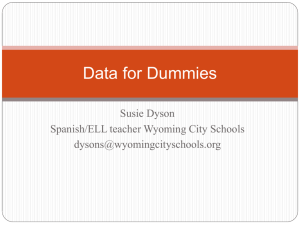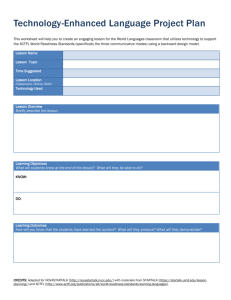Technology in Assessment
advertisement
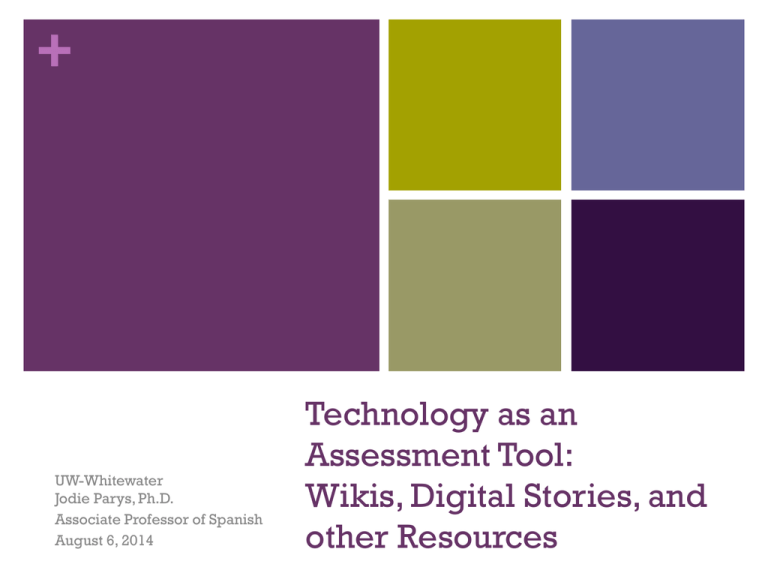
+ UW-Whitewater Jodie Parys, Ph.D. Associate Professor of Spanish August 6, 2014 Technology as an Assessment Tool: Wikis, Digital Stories, and other Resources + Technology as an Assessment Tool: Wikis, Digital Stories, and other Resources OVERVIEW ACTFL Position Statement Pedagogical Three considerations modes of assessment Examples with evaluation methods and rubrics Discussion and Practice + ACTFL Position Statement on the Role of Technology in Language Learning The American Council on the Teaching of Foreign Languages (ACTFL) acknowledges and encourages using the potential of technology as a tool to support and enhance classroombased language instruction. The use of technology should never be the goal in and of itself, but rather one tool for helping language learners to use the target language in culturally appropriate ways to accomplish authentic tasks. All language learning opportunities…should be standardsbased and help develop students' proficiency in the target language through interactive, meaningful, and cognitively engaging learning experiences, facilitated by a qualified language teacher. (http://www.actfl.org/news/position-statements/role-technology-language-learning) + Pedagogical Considerations Technology use in the language classroom should: Support and enhance classroom-based language instruction Help language learners to use the target language in culturally appropriate ways to accomplish authentic tasks Provide interactive, meaningful, and cognitively engaging learning experiences (http://www.actfl.org/news/position-statements/role-technology-language-learning) + Discussion Question What are your favorite technology resources in the language classroom? + Standards-Based Performance Assessment Interactive graphic: http://wimedialab.org/worldlanguageassessment/clover.htm + Characteristics: The 3 Modes of Communication Interpretive Mode: listening, reading, viewing authentic, text-based (audio, written, video/film) materials monologic tasks (one-way communication) Interpersonal Mode: spontaneous communication (oral or written) negotiation of meaning dialogic tasks (two-way communication) Presentational Mode: speaking, writing monologic tasks (one-way communication) Rehearsed language usage + Technology use for Presentational Mode: Speaking VoiceThread: http://voicethread.com Vocaroo: Wimba: www.vocaroo.com http://www.wimba.com/index.php Photostory or Windows Movie Maker http://wimedialab.org/worldlanguageassessment/ Video.htm 1:13 to 6:44 Digital Storytelling + Technology use for Presentational Assessments: Speaking Assessment Mode: Presentational (Digital Story) Task Title: The Life of a Spanish-speaking Immigrant to the United States Theme: Immigration Interpretive Mode Assessed: Speaking Courses: Spanish 321/322: Advanced Language Study National Standards: Communication Cultures Connections Comparisons Communities Description of Task: Student will create and share a digital story or movie about the life of an immigrant from a Spanish speaking country to the United States. This can be a famous person, a character from a piece of literature or movie, or someone the student has interviewed (and who has given their consent for their story to be shared with our class). + Technology use for Presentational Assessments: Speaking Steps to complete the task: Identify the subject of your presentation. If it is someone you will be interviewing, arrange for an interview. Be prepared to tape-record parts of the interview so you can include clips in your digital story. If it is someone from history, do research on his/her life. If it is a character from literature or film, review the source text for points you’d like to highlight. Compile images that can be used for your story. These can be photographs or images that enhance your story. You may also consider stills from films. Begin to organize the narrative structure of your story. You will record yourself as a “voiceover” for your digital story/movie. This will be a total of 5 minutes in length and will be set to the images you organize. You may also include short clips from any interviews you’ve conducted or from source texts such as films, interviews, etc. (with proper citation). Use a digital storytelling program to begin to organize and edit your images and link them to your audio. Some recommended programs (most available with a free download) are: Audacity, Windows Photo Story, Windows Movie Maker, iMovie, Photoshop, or PowerPoint. Review the finished product to make sure the images and narration have a logical link and effectively tell the story you are hoping to convey. Prepare a brief (1-2 minute) live oral introduction to your digital story in the target language, then show the film, and then field follow-up questions by the audience in the target language Review the rubric to be sure you adhere to all of the specific task requirements. + Technology use for Presentational Assessments: Speaking Digital Storytelling Examples Example Example 1: Claire’s story about her aunt 2: Jason’s interview with a family friend who immigrated to the United States + Discussion Question What are other ways you could utilize digital stories as an assessment tool in your language classroom? + Technology use for Presentational Assessments: Writing Snapfish or Shutterfly to practice captioning pictures. Wiki: https://wiki.uww.edu/class/2141-SPANISH-322-01/index.php/Wiki_1 Sample Checklist for Wiki ______ Contributed to the discussion by the deadline. ______ Wrote the entire entry in the target language. ______ Met the minimum length requirement (20 sentences). ______ Had 10 or fewer grammatical errors. **Note that this counts for 2 points. ______ Had 5 or fewer vocabulary errors. ______ Responded to each of the writing prompts. ______ Used transitions and showed a level of sophistication appropriate for Spanish 321. ______ Corrected at least one error on five of your peers’ wikis. ______ Corrected your own wiki and produced a final version. + Technology use for Presentational Assessments: Writing Wiki is helpful for: Process-writing Formative assessments Peer editing Building self-awareness regarding errors Building block toward larger, summative assessments with more formal rubrics (see department example) + Discussion Question In what additional ways could wikis support your pedagogical and assessment goals in the language classroom? + Technology Use for Interpretive Assessments: Listening or viewing Youtube Deutsche Welle for audio, text, and video content, as well as didacticized activities in German: http://www.dw.de/learngerman/s-2469 Radio France internationale for listening activities, current events, other language activities: http://www1.rfi.fr/lfen/statiques/accueil.asp TV5 Monde has a page for French learners with listening and current events activities for different levels: http://apprendre.tv5monde.com/ Audio books in Spanish: www.albalearning.com Audio clips of Spanish and Latin American poems, some read by the poets themselves: www.palabravirtual.com Radio Televisión Española's website: www.rtve.es + Technology Use for Interpretive Assessments: Reading Examples of sites with authentic texts Center for Language Education and Research: http://clear.msu.edu/clear/index.php Latin American Network Information Center: http://lanic.utexas.edu/ Deutsche Welle: http://www.dw.de/learn-german/s-2469 Biblioteca Virtual Miguel de Cervantes site: www.cervantesvirtual.com + Discussion Question What other technology resources have you used or could you use to create interpretive assessments? + Technology Use for Interpersonal Communication: Conversation Wimba: http://www.wimba.com/index.php VoiceThread: http://voicethread.com Vocaroo: www.vocaroo.com Skype or FaceTime for oral interviews. Potential benefits of Skype or FaceTime for oral interviews: Ideal for a distance -learning or hybrid class Can accommodate non-traditional students with irregular schedules Provides practice for the OPIc + Technology Use for Interpersonal Communication: Conversation SAMPLE ORAL COMMUNICATION ASSESSMENT TASK SHEET Assessment Mode: Interpersonal (Interview) Task Title: Study Abroad Placement Interview Theme: Study Abroad National Standards: Communication Cultures Connections Comparisons Communities Time Frame: Task should take 15 minutes total per student (5 min. explanation; 10 min. conversation). Description of Task: Instructor will simulate an interview with the student for potential study abroad placement. During the conversation, which will take place via Skype, the instructor will ask student about his/her previous language study, interests, hobbies, family and other activities to help “place” the student in a program and with a family that is a good match for the students’ abilities and interests. Instructor will also ask student about his/her specific goals for the study abroad experience and what s/he hopes to learn, see, do, and experience. Lastly, the student will be asked to describe his/her ideal host family and living arrangements. + Technology Use for Interpersonal Communication: Conversation Length of Student Response(s): The interview will last 10 minutes per student and students will be allowed ample time to answer each question to allow students the opportunity to produce a cohesive narrative. Materials Needed: Questions/prompts designed by instructor. Instructor Notes: Students have prior knowledge of narration in the past, present and future using various tenses. Students also have prior knowledge of the vocabulary required to discuss personal interests, hobbies, family and activities. During previous classes (or throughout the semester), the instructor will have discussed the necessary background information (linguistic, lexical, grammatical, cultural) to ensure minimal success of task. Prior to the task, students will have had the opportunity to research potential study abroad programs in their target languages so they are familiar with the different options available. Students will also have been guided in the process of setting up and using Skype. + How to keep it all straight? To stay up-to-date on exciting new pedagogical tools, check out: http://www.scoop.it/t/tools-for-learners Another fun site: http://gratisography.com/ + Discussion Question Share your most successful technology-based assessment. What tools did you use? What made it particularly successful? + Questions or comments? Feel free to contact me at: parysj@uww.edu + Resources ACTFL. (2014). Position Statement: Role of Technology in Language Learning. Accessed on 21th June Web. 21 June 2014. World Language Assessment: Get in the Mode! (2008-2011). Curriculum Design for Learning World Languages. Accessed on 21st June Web. 21 June 2014. World Language Assessment: Get in the Mode! (2008-2011). Video on Demand: Technology in Assessment. Accessed on 21st June Web. 21 June 2014.
